6.30: Terrestrial Biomes
- Page ID
- 1494
\( \newcommand{\vecs}[1]{\overset { \scriptstyle \rightharpoonup} {\mathbf{#1}} } \)
\( \newcommand{\vecd}[1]{\overset{-\!-\!\rightharpoonup}{\vphantom{a}\smash {#1}}} \)
\( \newcommand{\dsum}{\displaystyle\sum\limits} \)
\( \newcommand{\dint}{\displaystyle\int\limits} \)
\( \newcommand{\dlim}{\displaystyle\lim\limits} \)
\( \newcommand{\id}{\mathrm{id}}\) \( \newcommand{\Span}{\mathrm{span}}\)
( \newcommand{\kernel}{\mathrm{null}\,}\) \( \newcommand{\range}{\mathrm{range}\,}\)
\( \newcommand{\RealPart}{\mathrm{Re}}\) \( \newcommand{\ImaginaryPart}{\mathrm{Im}}\)
\( \newcommand{\Argument}{\mathrm{Arg}}\) \( \newcommand{\norm}[1]{\| #1 \|}\)
\( \newcommand{\inner}[2]{\langle #1, #2 \rangle}\)
\( \newcommand{\Span}{\mathrm{span}}\)
\( \newcommand{\id}{\mathrm{id}}\)
\( \newcommand{\Span}{\mathrm{span}}\)
\( \newcommand{\kernel}{\mathrm{null}\,}\)
\( \newcommand{\range}{\mathrm{range}\,}\)
\( \newcommand{\RealPart}{\mathrm{Re}}\)
\( \newcommand{\ImaginaryPart}{\mathrm{Im}}\)
\( \newcommand{\Argument}{\mathrm{Arg}}\)
\( \newcommand{\norm}[1]{\| #1 \|}\)
\( \newcommand{\inner}[2]{\langle #1, #2 \rangle}\)
\( \newcommand{\Span}{\mathrm{span}}\) \( \newcommand{\AA}{\unicode[.8,0]{x212B}}\)
\( \newcommand{\vectorA}[1]{\vec{#1}} % arrow\)
\( \newcommand{\vectorAt}[1]{\vec{\text{#1}}} % arrow\)
\( \newcommand{\vectorB}[1]{\overset { \scriptstyle \rightharpoonup} {\mathbf{#1}} } \)
\( \newcommand{\vectorC}[1]{\textbf{#1}} \)
\( \newcommand{\vectorD}[1]{\overrightarrow{#1}} \)
\( \newcommand{\vectorDt}[1]{\overrightarrow{\text{#1}}} \)
\( \newcommand{\vectE}[1]{\overset{-\!-\!\rightharpoonup}{\vphantom{a}\smash{\mathbf {#1}}}} \)
\( \newcommand{\vecs}[1]{\overset { \scriptstyle \rightharpoonup} {\mathbf{#1}} } \)
\( \newcommand{\vecd}[1]{\overset{-\!-\!\rightharpoonup}{\vphantom{a}\smash {#1}}} \)
\(\newcommand{\avec}{\mathbf a}\) \(\newcommand{\bvec}{\mathbf b}\) \(\newcommand{\cvec}{\mathbf c}\) \(\newcommand{\dvec}{\mathbf d}\) \(\newcommand{\dtil}{\widetilde{\mathbf d}}\) \(\newcommand{\evec}{\mathbf e}\) \(\newcommand{\fvec}{\mathbf f}\) \(\newcommand{\nvec}{\mathbf n}\) \(\newcommand{\pvec}{\mathbf p}\) \(\newcommand{\qvec}{\mathbf q}\) \(\newcommand{\svec}{\mathbf s}\) \(\newcommand{\tvec}{\mathbf t}\) \(\newcommand{\uvec}{\mathbf u}\) \(\newcommand{\vvec}{\mathbf v}\) \(\newcommand{\wvec}{\mathbf w}\) \(\newcommand{\xvec}{\mathbf x}\) \(\newcommand{\yvec}{\mathbf y}\) \(\newcommand{\zvec}{\mathbf z}\) \(\newcommand{\rvec}{\mathbf r}\) \(\newcommand{\mvec}{\mathbf m}\) \(\newcommand{\zerovec}{\mathbf 0}\) \(\newcommand{\onevec}{\mathbf 1}\) \(\newcommand{\real}{\mathbb R}\) \(\newcommand{\twovec}[2]{\left[\begin{array}{r}#1 \\ #2 \end{array}\right]}\) \(\newcommand{\ctwovec}[2]{\left[\begin{array}{c}#1 \\ #2 \end{array}\right]}\) \(\newcommand{\threevec}[3]{\left[\begin{array}{r}#1 \\ #2 \\ #3 \end{array}\right]}\) \(\newcommand{\cthreevec}[3]{\left[\begin{array}{c}#1 \\ #2 \\ #3 \end{array}\right]}\) \(\newcommand{\fourvec}[4]{\left[\begin{array}{r}#1 \\ #2 \\ #3 \\ #4 \end{array}\right]}\) \(\newcommand{\cfourvec}[4]{\left[\begin{array}{c}#1 \\ #2 \\ #3 \\ #4 \end{array}\right]}\) \(\newcommand{\fivevec}[5]{\left[\begin{array}{r}#1 \\ #2 \\ #3 \\ #4 \\ #5 \\ \end{array}\right]}\) \(\newcommand{\cfivevec}[5]{\left[\begin{array}{c}#1 \\ #2 \\ #3 \\ #4 \\ #5 \\ \end{array}\right]}\) \(\newcommand{\mattwo}[4]{\left[\begin{array}{rr}#1 \amp #2 \\ #3 \amp #4 \\ \end{array}\right]}\) \(\newcommand{\laspan}[1]{\text{Span}\{#1\}}\) \(\newcommand{\bcal}{\cal B}\) \(\newcommand{\ccal}{\cal C}\) \(\newcommand{\scal}{\cal S}\) \(\newcommand{\wcal}{\cal W}\) \(\newcommand{\ecal}{\cal E}\) \(\newcommand{\coords}[2]{\left\{#1\right\}_{#2}}\) \(\newcommand{\gray}[1]{\color{gray}{#1}}\) \(\newcommand{\lgray}[1]{\color{lightgray}{#1}}\) \(\newcommand{\rank}{\operatorname{rank}}\) \(\newcommand{\row}{\text{Row}}\) \(\newcommand{\col}{\text{Col}}\) \(\renewcommand{\row}{\text{Row}}\) \(\newcommand{\nul}{\text{Nul}}\) \(\newcommand{\var}{\text{Var}}\) \(\newcommand{\corr}{\text{corr}}\) \(\newcommand{\len}[1]{\left|#1\right|}\) \(\newcommand{\bbar}{\overline{\bvec}}\) \(\newcommand{\bhat}{\widehat{\bvec}}\) \(\newcommand{\bperp}{\bvec^\perp}\) \(\newcommand{\xhat}{\widehat{\xvec}}\) \(\newcommand{\vhat}{\widehat{\vvec}}\) \(\newcommand{\uhat}{\widehat{\uvec}}\) \(\newcommand{\what}{\widehat{\wvec}}\) \(\newcommand{\Sighat}{\widehat{\Sigma}}\) \(\newcommand{\lt}{<}\) \(\newcommand{\gt}{>}\) \(\newcommand{\amp}{&}\) \(\definecolor{fillinmathshade}{gray}{0.9}\)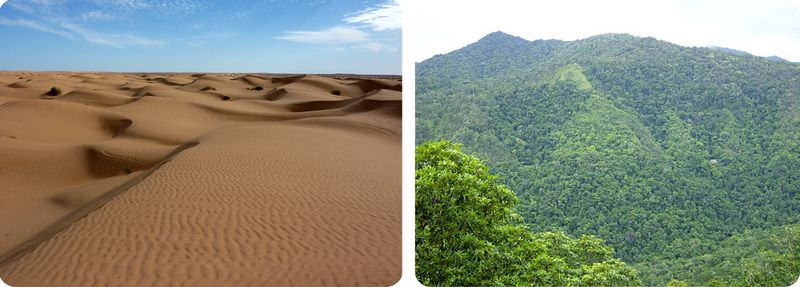
Forest vs. desert. What explains these differences?
If you look at these two pictures, you will see very few similarities. The picture on the left shows a desert in Africa. The picture on the right shows a rainforest in Australia. The desert doesn’t have any visible plants, whereas the rainforest is densely packed with trees. Do they have different climates? Does one get more rain than the other?
Survey of Terrestrial Biomes
Terrestrial biomes are classified by the climate and their biodiversity, especially the types of primary producers. The world map in Figure below shows where 13 major terrestrial biomes are found.
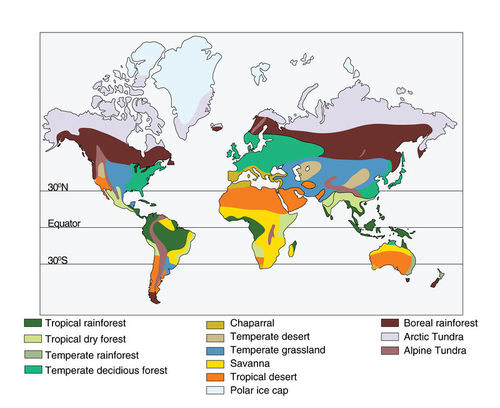 Worldwide Distribution of Terrestrial Biomes. This map shows the locations of Earth’s major terrestrial biomes.
Worldwide Distribution of Terrestrial Biomes. This map shows the locations of Earth’s major terrestrial biomes.The following figures summarize the basic features of major terrestrial biomes. As you read about each biome, think about how its biodiversity and types of plants and animals relate to its climate. For example, why do you think there are no amphibians or reptiles in tundra biomes? (Hint: Amphibians and reptiles cannot maintain a constant body temperature. Instead, they have about the same temperature as their surroundings.)
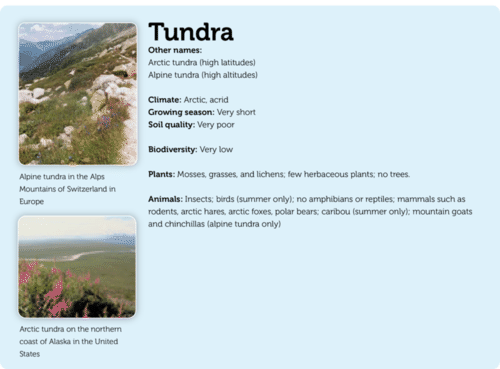
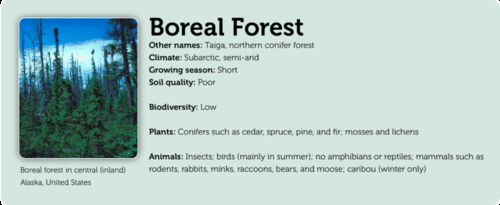
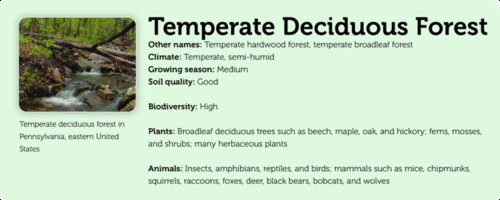
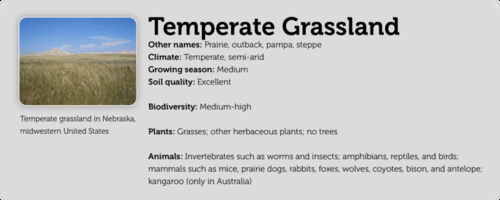
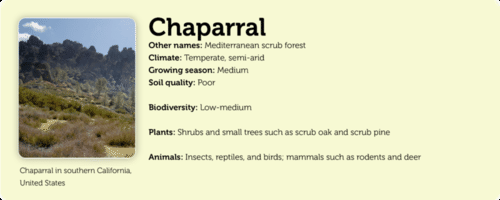
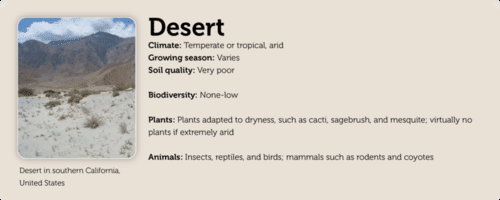

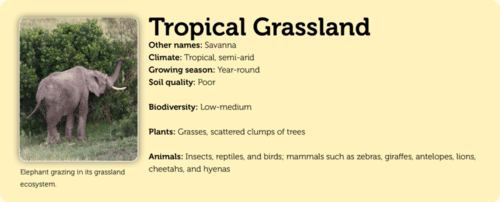
Science Friday: Superbloom: How Death Valley Springs to Life
A massive seed bank of desert wildflowers lies beneath Death Valley. This video by Science Friday shows that when heavy winter rains soak deep into the soil, these hidden wonders spring to life, in an event called a “superbloom”.
Summary
- Terrestrial biomes include tundras, temperate forests and grasslands, chaparral, temperate and tropical deserts, and tropical forests and grasslands.
Review
- Identify two types of tundra and where they are found.
- What terrestrial biome has the highest biodiversity? the lowest?
- In which biome are you most likely to find grasses, zebras, and lions?
- If you were to design a well-adapted desert animal, what adaptations would you give it to help it survive in its desert biome?
| Image | Reference | Attributions |
 |
[Figure 1] | Credit: Desert: Flickr:wonker; Rainforest: User:Tim35/Wikipedia Source: Desert: http://www.flickr.com/photos/wonker/4300437105/ ; Rainforest: commons.wikimedia.org/wiki/File:Rainforrest_between_Kuranda_and_Cairns ; _North_East_Queensland.jpg License: Desert: CC BY 2.0; Rainforest: Public Domain |
 |
[Figure 2] | Credit: CK-12 Foundation Source: CK-12 Foundation License: CC BY-NC 3.0 |
 |
[Figure 3] | Credit: CK-12 Foundation, Fawcett5/Wikimedia Commons, U.S. Fish and Wildlife Service Source: commons.wikimedia.org/wiki/File:Alpine_flora.png ; commons.wikimedia.org/wiki/File:Tundra_coastal_vegetation_Alaska.jpg License: CC BY-NC |
 |
[Figure 4] | Credit: National Oceanic and Atmospheric Administration Source: commons.wikimedia.org/wiki/File:Picea_mariana_taiga.jpg License: CC BY-NC |
 |
[Figure 5] | Credit: CK-12 Foundation, Nicholas A. Tonelli Source: www.flickr.com/photos/nicholas_t/6958582046/ License: CC BY-NC 2.0 |
 |
[Figure 6] | Credit: Brian Kell, CK-12 Foundation Source: commons.wikimedia.org/wiki/File:Oglala_National_Grassland.jpg License: CC BY-NC 2.0 |
 |
[Figure 7] | Credit: CK-12 Foundation, Miguel Vieira Source: www.flickr.com/photos/miguelvieira/3384303160/ License: CC BY-NC 2.0 |
 |
[Figure 8] | Credit: Ju Dadalto, CK-12 Foundation Source: http://www.flickr.com/photos/black-bird/2584138571/ License: CC BY-NC 2.0 |
 |
[Figure 9] | Credit: lana.japan; Flickr, Ethan Roos Source: http://www.flickr.com/photos/13007595@N05/2697183159/ License: CC BY-NC 2.0 |
 |
[Figure 10] | Credit: Shankar S., CK-12 Foundation Source: https://www.flickr.com/photos/shankaronline/7513383356/ License: CC BY-NC 2.0 |

